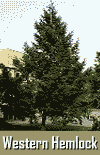Hemlock
Those who have traveled through the dense forests of the American Northwest or who have admired many of the most impressive of the eastern conifers are familiar with hemlocks. They are large, graceful trees known for their pyramidal shape and gently drooping branches. The delicate leaves of the hemlock, dark green and shiny above and silvery white beneath, provide dense shade in the forest or home landscape. Four hemlock species are native to the United States, with two found in the east and two in the west.
The Hemlock’s Place in History
Early Native Americans and the settlers who learned from them valued the hemlock for the tannin in its bark. Medicinal teas were brewed from the bark, while ointments were made to treat burns and sores. The bark’s tannin was also important in the tanning of leather. In addition, the bark was used to produce dyes for leather and wool, a practice that lives on today in parts of the country.
Some Common Species
The western hemlock (Tsuga heterophylla) dominates much of the forest land of the Pacific Northwest, in part due to its ability to thrive in the densest shade and so overtake trees requiring more light. It is also at home in rocky soil, adding to its tough adaptability. This large, beautiful tree boasts delicate foliage and a youthful pyramidal shape which gives way to a gentler, more drooping form at maturity. This sylvan giant can grow to 150 feet or more and live for centuries. Its native range is from Alaska south to parts of California, and it is a common tree in the coniferous rain forests of America’s Northwest coast. As well as being esteemed for its beauty, today the western hemlock plays an important part in the lumber industry. Its wood is used for paneling, flooring, and furniture, and to produce rayon yarns, cellophane, and plastics. (Grows in hardiness zone 6 and in suitable sections of other zones.)
Eastern hemlock (Tsuga canadensis) is native to the eastern United States and is a popular landscape tree in spaces that can accommodate its expansive grace. It is equally at home standing alone, in a grouping, or as part of a hedge, and it is easily pruned or sheared. Eastern hemlock usually grows from 40 to 70 feet tall, though it can reach 100 feet or more. Its beautiful foliage and form, as well as its hardiness and longevity, make it one of the most attractive of all the American conifers. (Grows in hardiness zones 3 to 8.)

